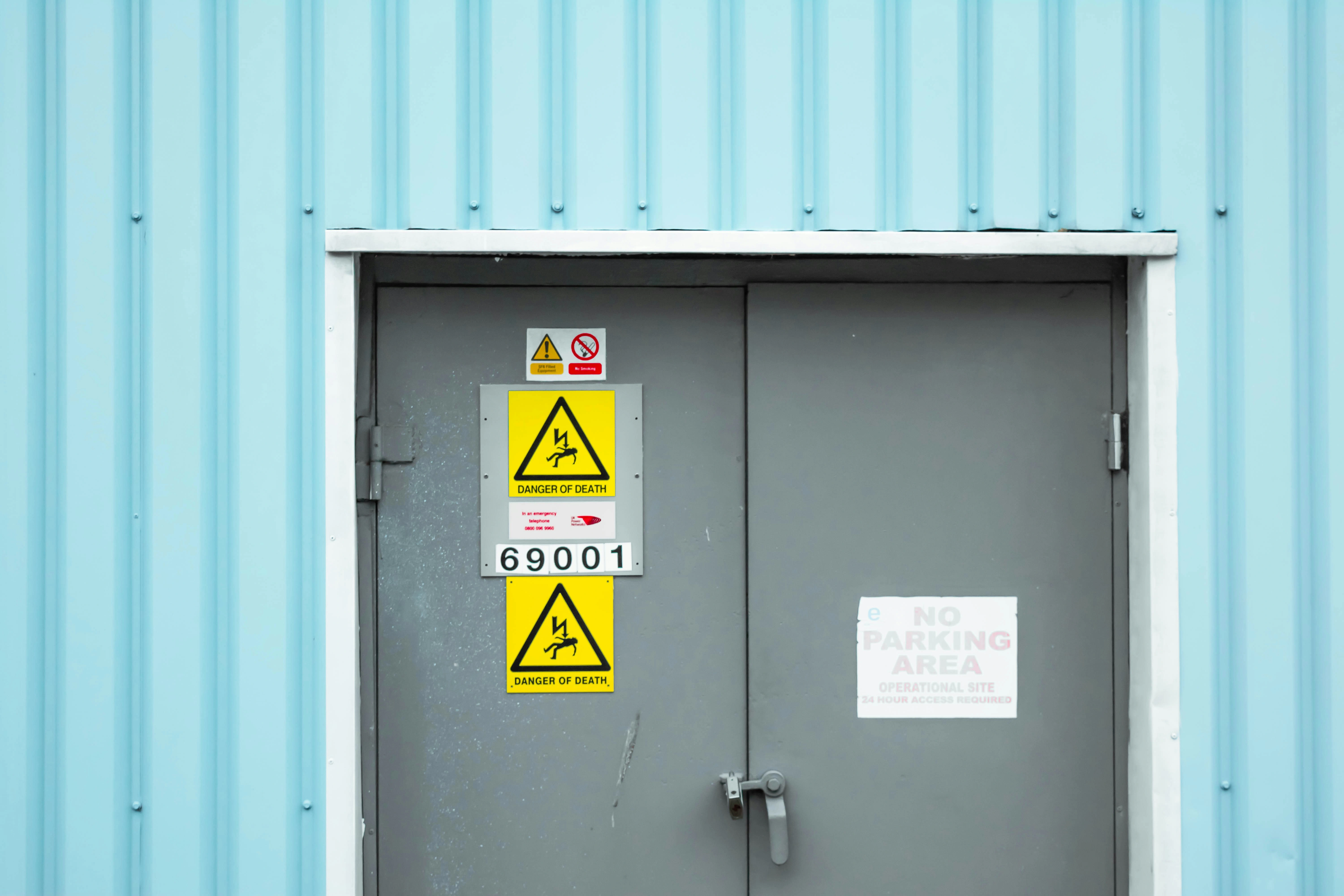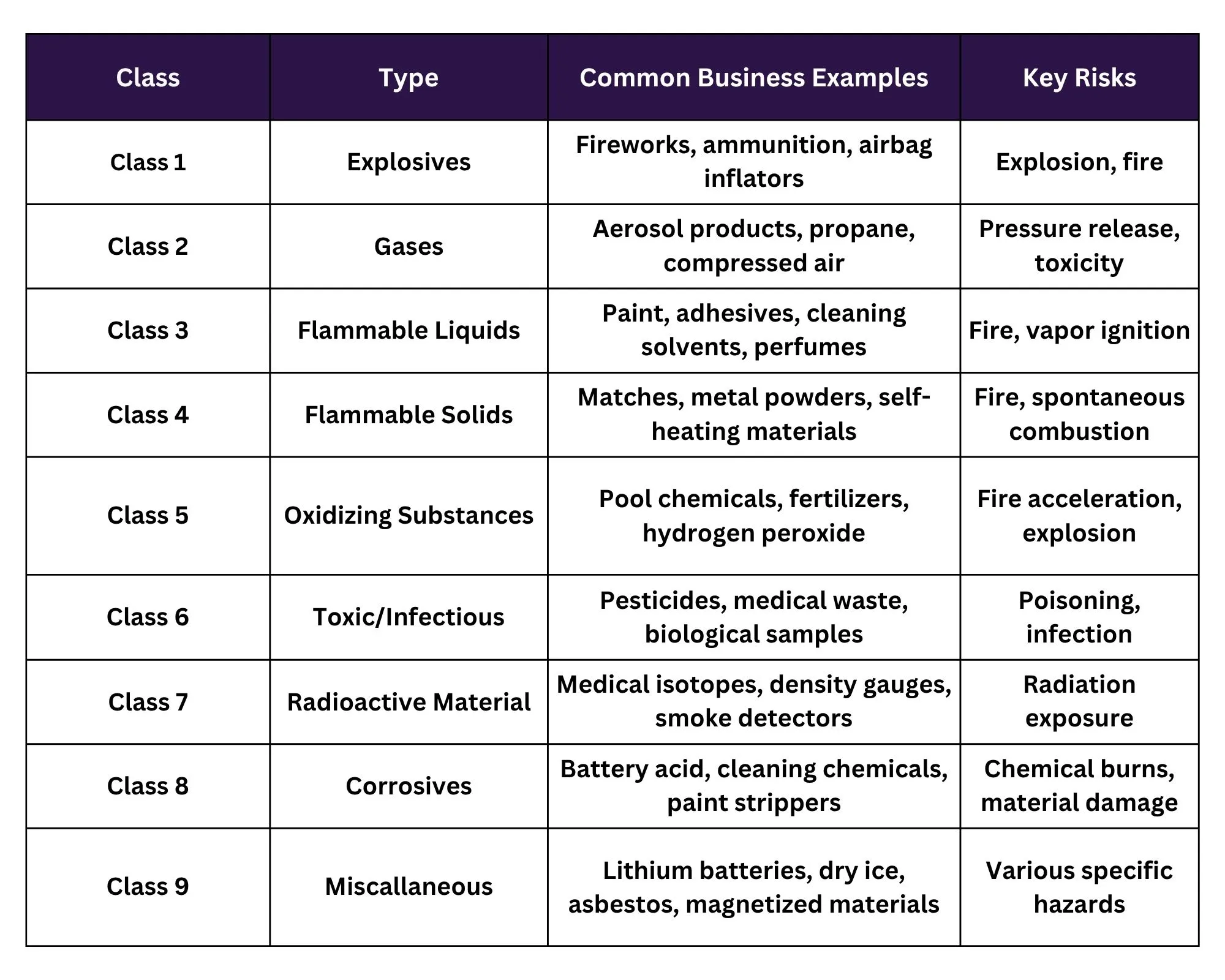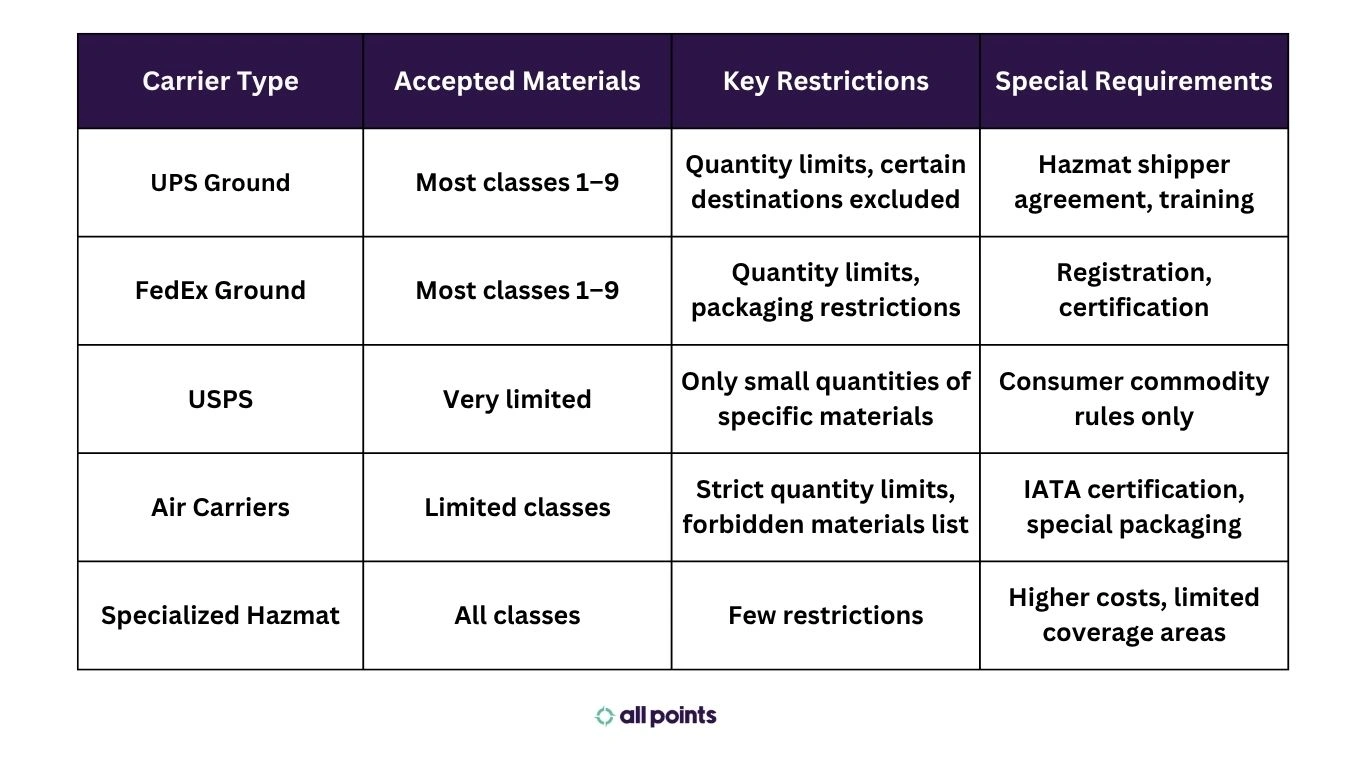So you've built a successful business selling products that contain lithium batteries, cleaning chemicals, or aerosol sprays. Your customers love what you offer, but you're discovering that shipping these items isn't as straightforward as sending regular packages. Welcome to the complex world of shipping hazardous materials—a regulatory maze that can turn profitable products into logistical nightmares if you're not prepared.
The reality is that many everyday business products fall under hazardous materials regulations, from the lithium ion batteries in electronics to the cleaning solvents in maintenance supplies. While these federal regulations exist to protect everyone in the supply chain, they create significant challenges for business owners who must navigate packaging requirements, labeling requirements, and shipping papers while ensuring compliance with 49 CFR (Code of Federal Regulations). The good news? Partnering with an experienced third-party logistics provider like All Points can transform this regulatory burden into a competitive advantage, allowing you to focus on growing your business while experts handle the complexities of transporting hazardous materials.
Understanding these regulations isn't just about compliance—it's about protecting your bottom line. Improper handling of hazardous materials shipments can result in hefty fines, rejected packages, carrier restrictions, and even legal liability. However, with the right knowledge and partnerships, you can successfully ship dangerous goods while maintaining safety and profitability.

What Are Hazardous Materials? Understanding the Basics
Before diving into the complexities of shipping regulations, it's crucial to understand what exactly qualifies as hazardous materials in the shipping world. According to the Department of Transportation and federal hazardous materials regulations found in 49 CFR, hazardous materials (you'll also see them called hazardous waste) are substances that pose risks to health, safety, property, or the environment during transportation. These materials designated as hazardous aren't limited to obviously dangerous items like explosives or toxic chemicals—they include many common business products.
The scope of hazardous materials might surprise you. Lithium batteries power everything from cell phones to power tools, yet they're classified as dangerous goods due to fire and explosion risks during transport. Similarly, everyday items like nail polish (flammable liquid), spray paint (aerosol), and even some perfumes fall under these regulations. The key factor isn't whether something seems dangerous in normal use, but whether it poses risks during the shipping process when packages may be jostled, exposed to temperature changes, or damaged.
Understanding this classification system is essential because the consequences of non-compliance are severe. The United States Department of Transportation can impose fines ranging from thousands to hundreds of thousands of dollars for violations. More importantly, improper shipping can lead to accidents, putting emergency responders and transportation workers at risk. That's why hazmat employees must receive specialized training requirements and why proper shipping procedures are non-negotiable in this industry.
Classification of Hazardous Materials
The foundation of safe hazardous materials shipping starts with proper classification. The Department of Transportation uses a systematic approach based on the UN (United Nations) Model Regulations, dividing dangerous goods into nine distinct hazard classes. Each class represents different types of risks, and understanding these classifications helps determine the specific packaging requirements, labeling requirements, and shipping restrictions that apply to your products.
This classification system isn't arbitrary—it's designed to help everyone in the supply chain understand the specific risks and safety measures needed for each type of hazardous material. The system also determines which carriers will accept your shipments, as many have restrictions on certain hazard classes.
Here's how the nine UN hazard classes break down, with common business examples:

Within each hazard class, materials are further divided into packing groups (I, II, or III) based on the degree of danger they present. Packing group I represents the highest danger level, requiring the most stringent packaging and handling requirements, while packing group III represents the lowest danger level within that class. This system helps determine specific packaging requirements, quantity limitations, and shipping restrictions that apply to your products.
Packaging Requirements for Hazardous Materials
One of the most critical aspects of shipping hazardous materials safely and legally is meeting strict packaging requirements. Unlike regular packages where you might grab any available box, hazardous materials must be packaged in containers that meet UN specifications and have passed rigorous performance testing. These requirements aren't suggestions—they're mandated by 49 CFR and enforced by carriers who will reject improperly packaged dangerous goods.
The packaging system for hazardous materials follows a precise hierarchy designed to contain the material and protect against the specific hazards it presents. Most hazardous materials require combination packaging, which includes inner packaging (the immediate container holding the hazardous material) and outer packaging (the shipping container). The outer packaging must bear UN specification markings that prove it has passed required performance tests for your specific type of hazardous material and packing group.
Understanding these requirements is crucial because packaging failures represent one of the most common reasons for shipping delays and rejections. A single improperly packaged item can result in carrier refusal, additional fees, and potential regulatory violations. For businesses shipping multiple hazardous materials, each product may require different packaging specifications, making compliance a complex and time-consuming process that often requires specialized knowledge and materials that can significantly impact your shipping costs.
Labeling and Marking Requirements
Proper labeling and marking of hazardous materials packages serves as the critical communication link between your business and everyone who handles your shipments. These labels and markings inform everyone along the shipment process about the specific hazards and proper handling procedures for your packages. The labeling requirements under 49 CFR are detailed and specific, with little room for interpretation or error.
Every hazardous materials package must display several key elements: the proper shipping name, identification number, hazard class labels, and orientation markings when required. The proper shipping name isn't simply what you call your product—it's the specific technical name listed in the hazardous materials table that precisely describes the chemical or material being shipped. This name must appear exactly as specified in the regulations, and using incorrect or abbreviated names can result in package rejection.
The visual impact of proper labeling cannot be understated. Diamond-shaped hazard class labels use internationally recognized symbols and colors to immediately communicate risks, while identification numbers provide quick reference for emergency responders. However, the complexity of these requirements means that many businesses struggle with compliance, especially when shipping multiple products with different hazard classifications, which is why partnering with experts who understand these intricate requirements can save both time and money.

Essential Documentation for Hazmat Shipping
Documentation represents the backbone of compliant hazardous materials shipping, and the paperwork requirements can overwhelm businesses new to dangerous goods transportation. Every hazardous materials shipment must be accompanied by proper shipping papers that include specific information formatted according to 49 CFR requirements. These documents serve multiple purposes: they provide essential information to carriers and emergency responders, create a legal record of the shipment, and demonstrate your compliance with applicable regulations.
The basic description required on shipping papers follows a strict format that includes:
- proper shipping name
- identification number
- hazard class
- packing group
And all of this needs to be in a specific order. Additionally, you must include the total quantity of hazardous materials, unit of measure, and a certification statement signed by a trained individual. For lithium batteries and other specific materials, additional information may be required, and international shipments add another layer of documentation complexity that can be particularly challenging for businesses without specialized expertise.
Missing or incorrect documentation is one of the fastest ways to halt your shipments and incur unexpected costs. Beyond the immediate shipping delays, improper documentation can trigger regulatory investigations and fines. A safety data sheet must also accompany many hazardous materials shipments, providing detailed information about the material's properties and emergency procedures. For businesses shipping multiple hazardous materials or dealing with international customers, maintaining accurate documentation becomes a full-time responsibility that requires ongoing training and attention to detail.
Safe Handling and Storage Procedures
The safe handling and storage of hazardous materials extends far beyond simply putting products on shelves—it requires specialized facilities, trained personnel, and strict adherence to safety protocols designed to protect workers and prevent accidents. These requirements become particularly challenging for businesses handling multiple types of dangerous goods, as different materials may require incompatible storage conditions or pose risks when stored together.
Proper storage facilities for hazardous materials must meet specific requirements outlined in 49 CFR and other applicable regulations. This includes appropriate ventilation systems, fire suppression equipment, secondary containment for liquids, and segregation areas for incompatible materials. For example, lithium batteries require dry storage conditions and protection from physical damage, while combustible liquids need fire-resistant storage areas with proper ventilation. The costs of retrofitting existing facilities or building compliant storage areas can be substantial for businesses.
Training requirements for hazmat employees add another layer of complexity and cost to in-house handling. Anyone who handles, stores, or ships hazardous materials must receive specific training covering general awareness, function-specific requirements, safety protocols, security awareness, and in-depth security training. This training must be renewed regularly and documented meticulously. For smaller businesses, the time and cost investment in proper training can be significant, making outsourcing to experienced partners an attractive alternative.
Carriers That Ship Hazardous Materials
Not all shipping carriers handle hazardous materials, and those that do impose strict requirements and limitations that can significantly impact your shipping options and costs. Understanding which carriers accept different types of dangerous goods, and under what conditions, is essential for maintaining reliable shipping operations. The landscape of hazmat shipping is complex, with each carrier maintaining its own policies within the framework of federal regulations.
Ground shipments generally offer more flexibility for hazardous materials than air transportation, but even ground carriers have specific restrictions. Major carriers like UPS and FedEx have detailed hazmat programs that require shipper registration, training, and compliance with their specific procedures in addition to federal requirements. These carriers typically accept most classes of hazardous materials for ground shipments but may restrict quantities, packaging types, or destinations based on their internal policies and risk assessments.
Air shipments face much stricter limitations due to safety concerns and International Civil Aviation Organization (ICAO) rules. Many hazardous materials are prohibited from air transportation entirely, while others face severe limitations (you can only send a limited quantity) or special requirements for their packaging. The ICAO technical instructions provide the framework for international air transport of dangerous goods, but individual airlines may impose additional restrictions. This complexity often leaves businesses struggling to find reliable, cost-effective shipping options for their hazardous materials.
Here's a breakdown of common carrier policies for transporting hazardous materials:

The Hidden Costs and Complexity of In-House Hazmat Shipping
Managing hazardous materials shipping in-house involves far more costs than many business owners initially realize, extending well beyond basic shipping fees to encompass training, specialized equipment, compliance monitoring, and risk management. These hidden expenses can quickly erode profit margins and divert resources from core business activities. Understanding the true cost of in-house hazmat shipping helps businesses make informed decisions about whether to handle these operations internally or partner with specialized providers.
The initial investment in compliance can be substantial. Hazmat employees must receive comprehensive training that costs hundreds of dollars per person and requires regular renewal. Specialized packaging materials for dangerous goods typically cost significantly more than standard packaging, and many materials require UN specification containers that must be purchased from certified suppliers. Additionally, businesses need proper storage facilities that meet safety requirements, which may require significant facility modifications or separate storage areas for different types of hazardous materials.
Ongoing operational costs add another layer of expense that many businesses underestimate. Maintaining compliance requires staying current with changing regulations, updating training programs, and conducting regular audits of procedures and documentation. The time investment for key personnel can be significant, particularly for businesses shipping multiple types of hazardous materials or serving international markets. When you factor in the costs of rejected shipments, regulatory fines, and potential liability issues, many businesses find that the true cost of in-house hazmat shipping far exceeds their initial budget projections.
How All Points Simplifies Hazmat Shipping for Businesses
Partnering with All Points transforms the complex challenge of shipping hazardous materials into a streamlined, compliant operation that protects your business while reducing costs and administrative burden. Our specialized expertise in dangerous goods transportation means your hazardous materials shipments receive professional handling from trained experts who understand the intricate requirements of 49 CFR and other applicable regulations. This partnership allows you to focus on growing your business while we handle the complexities of hazmat compliance.
Our facility is specifically designed and equipped to handle various types of hazardous materials safely and efficiently. We maintain proper storage conditions for different hazardous substances, from climate-controlled areas for lithium batteries to segregated storage for incompatible materials. Our trained staff understands the specific handling requirements for everything from dry ice to lithium ion batteries, ensuring your products are stored and shipped in a compliant manner that meets all safety requirements.
The cost advantages of partnering with All Points extend beyond simple shipping fees. We eliminate the need for your business to invest in specialized training, packaging materials, storage facilities, and compliance monitoring systems. Our established relationships with carriers who accept hazardous materials ensure reliable shipping options at competitive rates. Additionally, our expertise in documentation and labeling requirements prevents costly shipping delays and regulatory issues that can plague businesses attempting to handle hazmat shipping without proper knowledge and systems.
Getting Started: Steps for Businesses Shipping Hazardous Materials
Taking the first steps toward compliant hazardous materials shipping begins with a thorough assessment of your products and shipping needs. Start by identifying which of your products qualify as hazardous materials using the hazardous materials table found in 49 CFR. This process requires careful analysis, as many everyday business products fall under hazmat regulations—from electronic devices containing lithium metal batteries to cleaning supplies containing combustible liquids. Don't rely on assumptions; even materials that seem harmless may require special handling during transportation.
Once you've identified your hazardous materials, evaluate your current shipping operations against federal hazardous materials regulations requirements. Consider the training requirements for your staff, the costs of compliant packaging and labeling, and the complexity of maintaining proper documentation for shipping papers. Factor in the limitations many carriers place on hazardous materials and the potential impact on your customer service and delivery times. This honest assessment will help you understand whether in-house handling or outsourcing makes more business sense.
The decision between managing hazmat shipping internally versus partnering with a 3PL like All Points often comes down to cost, complexity, and risk tolerance. If you choose to work with a hazmat-capable 3PL, look for providers with proper certifications, experienced hazmat employees, and established carrier relationships. The right partner should demonstrate expertise in your specific types of dangerous goods and provide transparent pricing that accounts for all aspects of compliance, from storage to final delivery.

Hazardous Materials Shipping FAQs
What are considered hazardous materials for shipping?
Hazardous materials for shipping include any substances that pose risks during transportation, classified into 9 UN hazard classes. Common examples include flammable liquids (paint, solvents), corrosives (battery acid, cleaning chemicals), gases (aerosols, compressed air), toxic substances (pesticides), and miscellaneous dangerous goods (lithium batteries, dry ice). Less common examples include cryogenic liquids (gases), medical waste (infectious substances), and radioactive material, which has its own class. The classification for each type of hazardous waste depends on the material's physical and chemical properties and potential risks during transport.
How do I ship hazardous materials with the USPS?
USPS has strict limitations on hazardous materials and generally only accepts very limited quantities of certain materials under specific conditions. Most business hazmat cannot be shipped via USPS. They may accept small quantities of some consumer commodities (like perfumes or nail polish) if properly packaged and declared, but businesses typically need to use specialized carriers like UPS or FedEx for hazmat shipping, or work with a 3PL that has proper carrier relationships.
What paperwork is required to ship hazardous materials?
Shipping hazardous materials requires dangerous goods declarations, shipping papers with complete hazmat descriptions, Material Safety Data Sheets (SDS), emergency response information, and shipper certification. International shipments require additional documentation. All paperwork must be completed accurately and signed by certified personnel if you're shipping hazmat, as incomplete or incorrect documentation will result in rejected shipments and potential penalties.
Can I ship hazardous material via FedEx?
Yes, FedEx accepts many types of hazardous materials, but with strict requirements and limitations. You must be a registered FedEx hazmat shipper, use proper UN specification packaging, complete dangerous goods declarations, and follow all labeling and documentation requirements, including having Material Safety Data Sheets (SDS). FedEx offers ground and air options for different types of hazmat, though air shipping has more restrictions. Many businesses find it easier to work with a 3PL that already has established FedEx hazmat shipping capabilities.
What is the best way to ship batteries?
The best way to ship batteries depends on the specific type, but lithium batteries require the most careful handling due to their classification as dangerous goods. To ship batteries safely, they must be properly labeled with appropriate class markings and packaged according to UN specifications. Ground transport is generally preferred for battery shipments as it offers more flexibility than air transportation, which has strict quantity limitations and restrictions. A safety data sheet should accompany battery shipments to provide emergency responders with critical information about the specific battery chemistry and hazards.

Conclusion
Navigating the world of hazardous materials regulations doesn't have to be a barrier to business growth. While the regulations governing dangerous goods transportation are complex and constantly evolving, understanding the basic requirements outlined in 49 CFR and working with experienced partners can turn compliance into a competitive advantage. Whether you're shipping lithium batteries, cleaning chemicals, or any other hazardous materials, proper handling protects your customers, your business, and everyone involved in the transportation process.The choice between handling hazmat shipping in-house versus partnering with a specialized 3PL often comes down to cost, expertise, and risk management. For many businesses, the hidden costs and complexity of maintaining compliance make outsourcing the more attractive option. All Points brings decades of experience in shipping dangerous goods, helping businesses navigate these challenges while maintaining safety and profitability.Don't let hazmat shipping requirements hold your business back. With proper knowledge, planning, and the right partnerships, you can successfully ship hazardous materials while focusing on what you do best—growing your business and serving your customers.





.webp)
.webp)
.webp)
.webp)
.webp)

